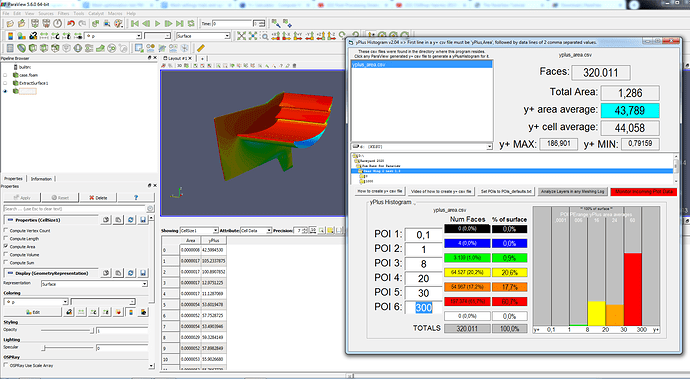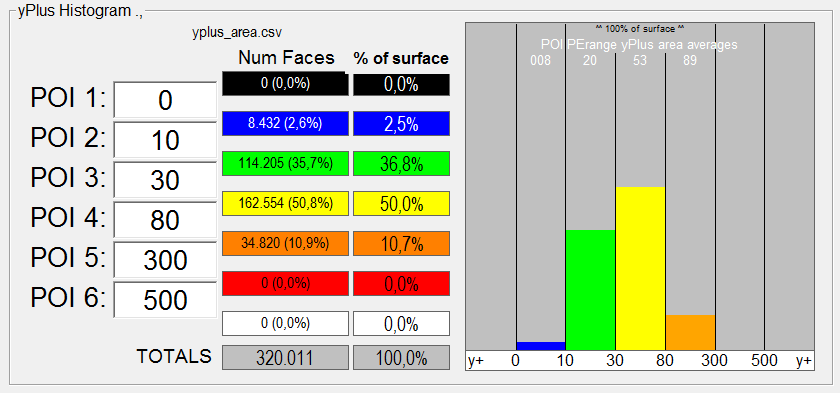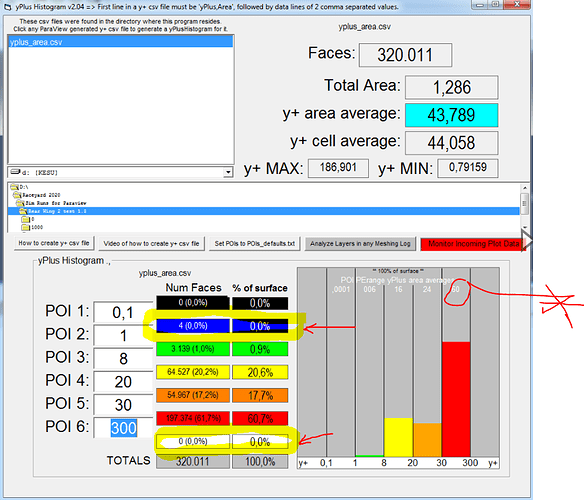I also am reading 4.6.2 is good for windows 7 - 64 bit
I am using 5.6.0, but the surface extraction and cell size filters should not have changed in like forever, so you should be fine with what works on your system…
Yep, too deep at this stage for yPlus evaluation, but k3 and w100 looks like a good place to start for you… As long as nut values end up being reasonable in your domain, that should be good for now…
We can go over the cfd-online turbulence calculator usage later if you don’t mind…
Soo i guess the cell size filter has changed because i cannot find it in the filters tab … unless i have to add it somehow
Darn, looks like cellsaize was added in March 2018, is there any way you can load at least 5.5.0-RC3 ![]() :
:
> On 19 March 2018 at 20:14, Scott, W Alan <wascott at sandia.gov> wrote: > >> By far, the easiest way to go is to use ParaView 5.5.0, out within the >> next month. There is a shiny new filter called Cell Size, that will give >> you volumes, surface area, etc of your dataset. It is available in >> Paraview 5.5.0-RC3, from the paraview.org website. Please let us know >> if you find any issues. >> >> >> >> Alan
ill try it. I have no idea which versions will work
What reason wouldn’t you try the latest version?
no reason i just thought it wouldnt be supported with windows 7 … Ill try the new one then
Success I think!
I followed your instructions and it all worked! this is your version 2 histogram system.
Changing to higher POL numbers, confirms that nothing is over 300
VERY GOOD, thank-you for being beta tester of v204 
Actually, once you understand all the numbers you see, you did not need to change the POIs…
Here we see that:
- There were 0 faces over 300 (red pointer)
- There were 4 faces less than 1 and >0.1 (other red pointer)
- The average value in the 30-300 range was 60 (red x)
- The Min of all faces was 0.79 (you find it
 )
) - The Max of all faces was 186.9 (you find it)
SOOOO, you have about 21.5% of surface area (22% of faces) <20, this is what you work on …
My default POIs use 8 and 20 specifically because, between these, is where both wall and full resolution formulas lose their accuracy… So my default POIs will work for BOTH full and wall meshes, of course you can always expand if you wish, but I think my default POIs are good for almost all meshes…
Have fun with ParaView 
Yes Paraview is quite overwhelming but i will enjoy learning more. I found the min max of all faces right after i uploaded the second pic. This histogram is so awesome though. It gives raw data that previously needed to be analyzed through just the surface color changes.
Now with the goal of getting as much Y+ area above 30. I have already changed the first cell height from 50 to 80. I cant increase Y+ much more with 3 layers with a 1.05 expansion ratio, without having a final thickness ratio over 1. I dont really want to have my final layer cell size to be larger then the surface cell size. Any recommendations? will using more layers help with the final layer to surface cell size ratio?
Edit. My calculated Y+ of 100 is equal to 0.002157 which is already larger then the level 9 cell size, which is 0.001953 so i need to find another way to get these results
Personally, I don’t think that is an issue but a test project needs to be completed if you want to do that…
I am tending to less # of layers nowadays for wall function use, but using more will not hurt and believe it or not sometimes you can make a mesh with less total cells by using more layers…
Eventually you will want to make sure your total BL layer thickness encompasses the turbulent near surface flow, start by checking your nut plots (I am under the understanding that the BL cells should properly capture areas of nut).
Wait until you try the ORSI monitoring feature live during a sim run to know when your results are stable enough to stop simulation manually… it is soo cool ![]()
You can forget the CALCULATED y+ now, you have direct feedback in what you really need to change by using y+ surface mapping values and getting them in range!!!
I would say that you need a double or triple thickness 1st layer to get those low y+ values over 20…
You can always go to pointed TEs etc and make all faces in your geo so that Level 10 works…
1mm features is still pretty fine and you can get much fewer cells…
The cells are calculated from the centroid correct? so that means that 1/2 the cell size is where measurements are being taken from. SO does this mean that i can somewhat assume how big the first cell should be to obtain a Y+ of around 30?
Again, forget all centroid stuff now… yPlus is linear with cell thickness (I think) , so to make a cell go from y+ 10 to 20 on the surface mapping, just double thickness you already have in the layering parms…
Do you mean moving to a lower surface refinement level so that i can have a better ratio of BL final cell to surface cell? I am worried about leading edge mesh quality on the elements at this point
I think LEs are good at L10 aren’t they?
I was talking about level 8 which is a BIGGER cell size. Reducing to level 10 would give me more cells



